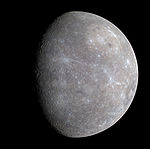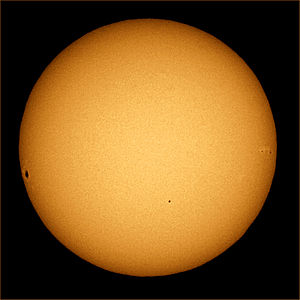- Transit of Mercury
-
A transit of Mercury across the Sun takes place when the planet Mercury comes between the Sun and the Earth, and Mercury is seen as a small black dot moving across the face of the Sun.
Transits of Mercury with respect to Earth are much more frequent than transits of Venus, with about 13 or 14 per century, in part because Mercury is closer to the Sun and orbits it more rapidly.
Transits of Mercury can happen in May or November. November transits occur at intervals of 7, 13, or 33 years ; May transits only occur at intervals of 13 or 33 years. The last three transits occurred in 1999, 2003 and 2006 ; the next will occur in 2016.
During a May transit, Mercury is near aphelion and has an angular diameter of 12"; during a November transit, it is near perihelion and has an angular diameter of 10".
Contents
Grazing transits of Mercury
Sometimes Mercury only grazes the Sun during a transit. In this case it is possible that in some areas of the Earth a full transit can be seen while in other regions there is only a partial transit (no second or third contact). The transit of November 15, 1999 was such a transit, and the previous one before that was on October 28, 743. The next such transit will occur on May 11, 2391.
It is also possible that a transit of Mercury can be seen in some parts of the world as a partial transit, while in others Mercury misses the Sun. Such a transit last occurred on May 11, 1937, and the previous one was on October 21, 1342. The next such transit will occur on May 13, 2608.
Simultaneous transits
The simultaneous occurrence of a transit of Mercury and a transit of Venus is extremely rare, and will next occur only in the years 69,163 and 224,508. The last simultaneous transit occurred in 373,173 BC. On September 13, 13,425 an almost identical event is predicted: a transit of Mercury and a transit of Venus will follow one after the other, in an interval of only 16 hours.
The simultaneous occurrence of a solar eclipse and a transit of Mercury is very rare. The last time this happened was September 20, 6945 BC.[1] The next solar eclipse occurring during a transit of Mercury will be on July 5, 6757. This solar eclipse will be visible from the South Pacific Ocean.[2]
Past and future transits
A spot on the Sun observed as early as 807 is believed by some experts to have been a transit of Mercury.[3] The first observation of a transit of Mercury was on November 7, 1631 by Pierre Gassendi. Johannes Kepler had however predicted the occurrence of transits of Mercury and Venus some time before that. He unsuccessfully attempted to observe the transit of Venus just one month later, but due to inaccurate astronomical tables he did not realize that it was not visible from most of Europe, including Paris. A transit of Venus was not observed until 1639, by Jeremiah Horrocks.
Past Transits of Mercury Transits of Mercury Date of
mid-transitTime (UTC) Notes Start Mid End 1631 Nov 7 Observed by Pierre Gassendi. 1651 Nov 3 Observed by Jeremy Shakerly in Surat, reported in letter to Henry Osbourne, January 1652, he is thought to have died in India around 1655.[4] 1661 May 3 Occurred on the day of the Coronation of King Charles II of England. Observed by Christiaan Huygens in London. 1677 Nov 7 Observed by Edmund Halley in St Helena, Richard Towneley in Lancashire, Jean Charles Gallet in Avignon; as reported in letter from John Flamsteed to Johannes Hevelius 23 May 1678 [5] 1743 Nov 5 Coordinated scientific observations were organized by Joseph-Nicolas Delisle worldwide. 1753 May 6 1769 Nov 9 23:09 Observed by Charles Green and James Cook from Mercury Bay in New Zealand.[6] Noted that Mercury had little or no atmosphere. 1802 Nov 9 06:16 08:58 11:41 1815 Nov 12 00:20 02:33 04:46 1822 Nov 5 01:04 02:25 03:45 1832 May 5 09:04 12:25 15:47 1835 Nov 7 17:35 20:08 22:41 1845 May 8 16:24 19:37 22:49 1848 Nov 9 11:07 13:48 16:28 1861 Nov 12 05:21 07:19 09:18 1868 Nov 5 05:28 07:14 09:00 1878 May 6 15:16 19:00 22:44 1881 Nov 7 22:19 00:57 03:36 1891 May 9 23:57 02:22 04:47 1894 Nov 10 15:58 18:35 21:11 1907 Nov 14 10:24 12:07 13:50 1914 Nov 7 09:57 12:03 14:09 1924 May 8 21:44 01:41 05:38 1927 Nov 10 03:02 05:46 08:29 1937 May 11 08:53 08:59 09:06 Only visible as partial transit in Southern Africa, Southern Arabia, South Asia and Western Australia. 1940 Nov 11 20:49 23:21 01:53 1953 Nov 14 15:37 16:54 18:11 1957 May 6 23:59 01:14 02:30 1960 Nov 7 14:34 16:53 19:12 [1] 1970 May 9 04:19 08:16 12:13 [2] 1973 Nov 10 07:47 10:32 13:17 [3] 1986 Nov 13 01:43 04:07 06:31 [4] 1993 Nov 6 03:06 03:57 04:47 [5] 1999 Nov 15 21:15 21:41 22:07 [6] Partial transit in Australia, Antarctica and New Zealand's South Island 2003 May 7 05:13 07:52 10:32 [7] 2006 Nov 8 19:12 21:41 00:10 [8] Future Transits of Mercury Transits of Mercury Date of
mid-transitTime (UTC) Notes Start Mid End 2016 May 9 11:12 14:57 18:42 2019 Nov 11 12:35 15:20 18:04 2032 Nov 13 06:41 08:54 11:07 2039 Nov 7 07:17 08:46 10:15 2049 May 7 11:03 14:24 17:44 2052 Nov 9 23:53 02:29 05:06 2062 May 10 18:16 21:36 00:57 2065 Nov 11 17:24 20:06 22:48 2078 Nov 14 11:42 13:41 15:39 2085 Nov 7 11:42 13:34 15:26 2095 May 8 17:20 21:05 00:50 2098 Nov 10 04:35 07:16 09:57 2108 May 12 01:40 04:16 06:52 See also
References
- Cunningham, Clifford J., "Mercury's Time to Shine," Mercury Sep-Oct 2006.
- ^ http://transit.savage-garden.org/sedt.html
- ^ http://transit.savage-garden.org/sedt/24/
- ^ http://www.floridastars.org/transit.mercury.info.html
- ^ Chapman, A. (1985), Transactions of the Historical Society of Lancashire and Cheshire Volume 135 p 1-14
- ^ Eric G. Forbes et al. (1995), Correspondence of John Flamsteed Volume 1, Institute of Physics Publishing, p. 624-627
- ^ Wayne Orchiston 1994, James Cook and the 1769 Transit OF Mercury, Carter Observatory ISSN 1173-7263 http://www.transitofvenus.co.nz/docs/CarterObservatoryInfo3.doc
External links
- NASA: Transits of Mercury, Seven Century Catalog: 1601 CE to 2300 CE
- NASA: Image from the transit of Mercury in 2003
- Shadow & Substance.com: Transit of Mercury Animated for November 8, 2006
- Transits of Mercury - Fourteen century catalog: 1 601 AD - 3 000 AD
- Transits of Mercury on Earth - Fifteen millennium catalog: 5 000 BC - 10 000 AD
Transit visibility from planets superior to the transiting body Mercury Observation 
Transits Exploration Properties Geology - Beagle Rupes
- Caloris Basin
- Discovery Rupes
- Rembrandt Basin
- Resolution Rupes
Other topics Categories:- Astronomical transits
- Mercury (planet)
- Astrological aspects
Wikimedia Foundation. 2010.


